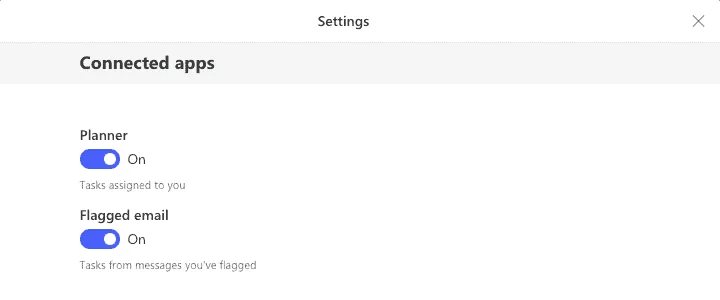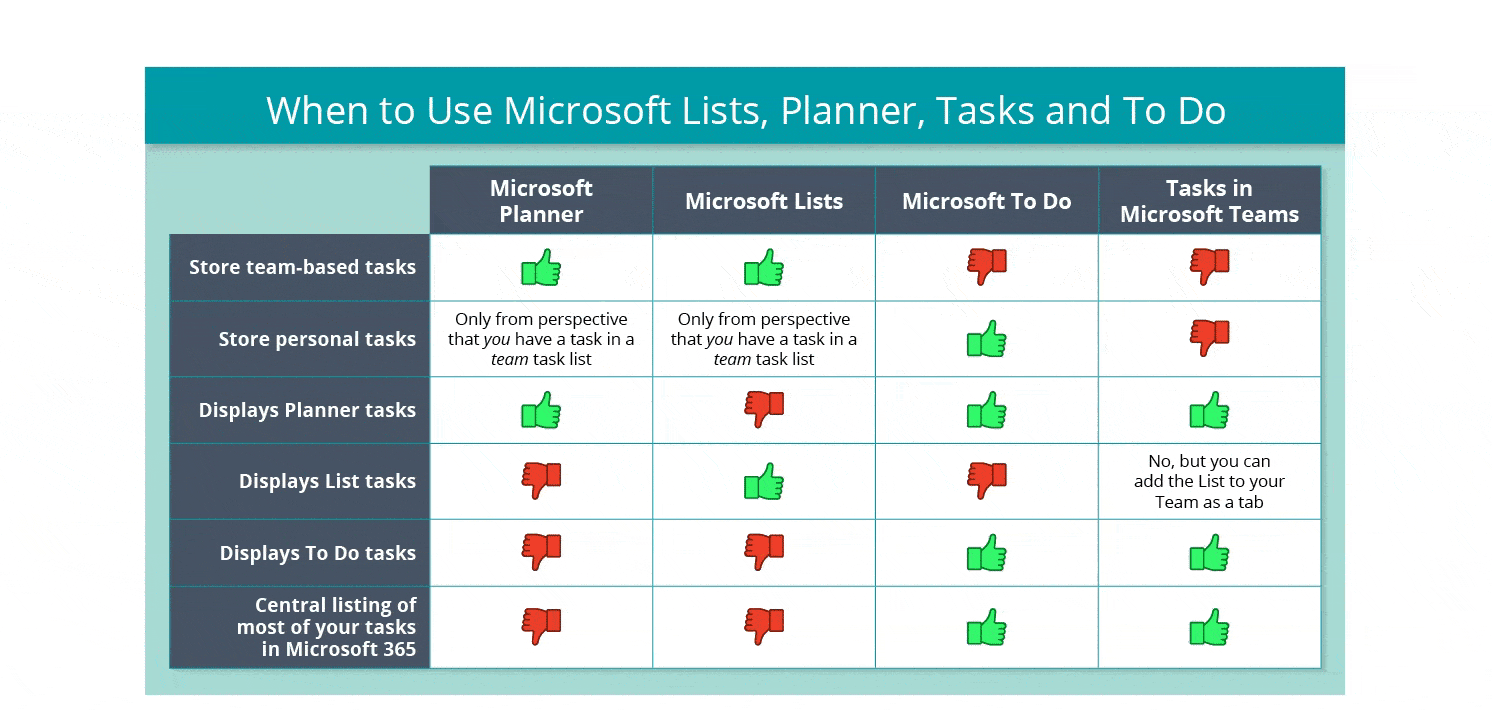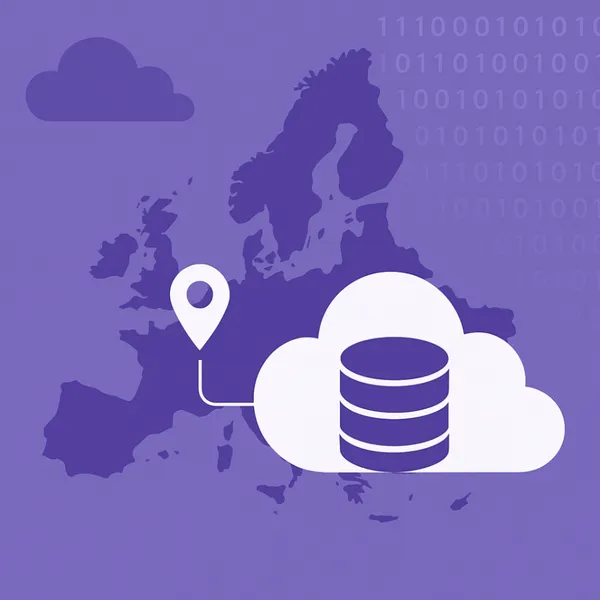
Knowledge base
October 01, 2020
Microsoft To Do, Planner, Lists or Tasks in Microsoft Teams?
2020 has proved to be an important year for new tools and features rolled out in Microsoft 365, including the introduction of Microsoft Lists – in fact a major update to the SharePoint lists, presented as a separate app – the new Tasks app in Microsoft Teams, and several upgrades to the two main task apps, Microsoft Planner and Microsoft To Do.
This raises many questions about which tool should be used when, and that includes confusion about overlap between these four apps. Good task management throughout your life is a nirvana that app creators around the world have tried to solve in the best possible way; there’s a reason there are thousands of results in the Google Play and Apple App stores for task apps.
But where do lists, planner, tasks and tasks fall into teams on the spectrum? There is some overlap and there are some aspects of these apps that are actually not just about tasks. So let’s dive in.
These apps don’t all do the same
Let’s see what these tools are really meant for. That doesn’t mean they can’t do more than what I’m dealing with, just that they’re not necessarily meant to:
Microsoft Planner is a user-friendly, team-based project management tool. It’s built into Microsoft 365 Groups, so every Outlook Group, Teams Team, and Yammer Community can track their outstanding tasks in a way that no formal project manager needs. It uses canban boards to track tasks and provide comprehensive information about each task. There is also a personalized view of Planner, so that each individual can see all their Planner tasks in groups and plans. Planner competes with tools like Trello, Wrike and Asana.
Microsoft Lists is an important feature and interface upgrade to SharePoint lists, broken down into its own app. While lists can be very useful for task tracking and project management, that’s not the only thing it’s good for. You can use lists to create custom tables and columns that best suit your needs, for example, to track inventory, create event schedules, manage travel plans, and more. This announcement blog post gives a good overview of what Lists can do, but you might prefer our view of Lists. Lists competes with tools such as monday.com, Asana and Wrike.
Microsoft To Do has replaced Wunderlist – an app Microsoft bought – and has found its way to replacing the job portion of Outlook, which is remarkable considering that “app” has been around for decades. Tasks track personal tasks in lists and groups managed by you, the user. But the big connection To Do has with the other apps is that it shows your Planner tasks and any highlighted emails from Outlook directly into the app (instructions below). Given the Power Automate connector, you can also add tasks from other apps, such as Microsoft OneNote. To Do lets you centralize your tasks in your Microsoft account.
Tasks in Teams is a recent addition to Microsoft Teams and a central list of your tasks in a Teams-friendly way. It is essentially a combination of planner and tasks within teams. It really doesn’t work; it simply centralizes your tasks in Teams, the app that Microsoft places the most emphasis on for their modern workplace vision. This recent announcement blog post provides a good overview of tasks in teams.
This basically means whether the app stores and manages your tasks or presents your tasks in one frame.
Planner and lists are great for adding and managing team-based tasks and to-do lists. To Do is great for adding and managing personal tasks and to-do lists. Tasks in Teams is essentially a display port to see all your tasks in Planner and Tasks. Currently, there is no integration to view List tasks assigned to you through Tasks and Tasks in Teams; That said, Lists is easy to add as a tab to each Team using the corresponding connector, so you can easily access the list and your other tasks through Teams.

Now that we’ve discussed the separation between saving tasks and viewing them, the real question of “Planner, Taken, Tasks in Teams or Lists” is divided into two questions:
• Planner or lists?
• Tasks or tasks in teams?
As with most technical solutions, the answer is: it depends.
Microsoft lists or Microsoft Planner?
While it seems like there’s a lot of overlap between Planning and Lists, it’s not as much as you might think. Yes, you can essentially recreate a planner experience with a list, but why would you do that if you don’t need the adaptability?
Use Planner: If you want quick, easy and easy-to-understand project management, use Planner. It works. It provides a lot of fields for your tasks, it can be integrated with To Do and Tasks in Teams, and it works great for both agile and waterfall project management, especially for small teams (i.e. not for enterprise portfolio management). You can view tasks in a board or calendar view, and there’s a nice dashboard overview. Planner is available as a web app, Teams tab, and mobile app.
Use lists: If you want a custom experience where you can manage the task fields, their options, their layout, their views, and more, you want a list. You also want a list if you’re trying to manage things that aren’t really tasks. This brings us to examples such as inventory registration, asset management, event routes and travel planning. You can view tasks (and other list items) in a list or calendar view. Lists is available as a web app, Teams tab, and mobile app.
But remember that if you’re really banking on having ToDo and Task in Teams integration, you should use Planner for team-based tasks.
Microsoft tasks or tasks in Microsoft Teams?
The choice between Tasks and Tasks in Teams is a little more difficult to make. It really is a judgment. Tasks in Teams is just a way to view your existing tasks in Tasks and Planner. That is, it actually only shows your existing tasks in To Do (since Planner tasks can be viewed in ToDo). But the way you look at them is different.
Use tasks: If you want a list of your tasks in a central place, especially one with a great mobile app and easy-to-set expiration dates and reminders (those push notifications really help!), then you want to use ToDo. To Do is great for managing your daily tasks, to help you draw up your personal schedule. Tasks is good for detailed task management. ToDo is available as a web app, desktop app and mobile app.
Use tasks in teams: If you prefer a larger view of your tasks, perhaps in a list of columns, you’ll probably prefer Tasks in teams. With Tasks in Teams, your tasks are also separated by Plan and Team, which means you can divide tasks by project and result, not just to complete an endless list of tasks assigned to you and that you must perform today, amirite?). If you never leave Microsoft Teams and it’s your central hub for work, use Tasks in Teams. Tasks in Teams are good for large-scale task management. Tasks in Teams are available through the Teams web app, desktop app, and mobile app.
Automatically add planner tasks and highlighted Outlook emails to tasks
I’ve said a few times that To Do integrates with Planner and Outlook, but I haven’t really explained how. These integrations aren’t enabled by default, so you’ll need to set them up yourself. But once you’ve connected the apps, you can use all versions of To Do (desktop app, web version, mobile app).
It’s probably easiest to do it from the web version of ToDo. Here’s how to do it:
- Browse to office.com, and then click Tasks. If you don’t see Tasks, click the waffle in the upper-left corner of the page> All Apps> Tasks.
- In the upper-right corner of Tasks, click gear> To-Do settings.
- In the Settings panel, scroll down to the Connected Apps section.
- Turn Planner and Highlighted Email on.
- Click the X in the upper-right corner of the panel to close it. Your settings are automatically saved.

If you’re looking for Gantt charts, look elsewhere
One thing you won’t see in any of these tools is the Gantt diagram functionality. This is probably because Microsoft Project – Microsoft’s premium project management tool – promotes this as core functionality and they don’t want to cannibalize their own premium app.
You’ll find Gantt chart functionality in the “old” tasks lists in SharePoint Online. They’re not great, but they do work. And you can sync a single project file with a SharePoint task list to save on licensing fees and protect different tasks from permissions.
The point is that if you’re hoping that one of these apps will meet this need, you’ll need to start looking at other tools, as Microsoft is unlikely to deliver fully functional Gantt charts in Planner of Lists. This is an important separation point from many of the competing list and task apps out there, especially Asana, Wrike, and monday.com, all of which contain Gantt views as part of their product offerings (although these apps, like Project, are at an additional cost).
That said, I haven’t even talked about Microsoft Project and Azure DevOP’s and their job management scenarios. And frankly, these two apps are on a very different level than the ones we’re dealing with in this post.
Project is really intended for large-scale projects involving professional project managers. And Azure DevOps – while this may irritate some of the more techies out there – is still a niche app for developers and the IT public. The question of when to use them really comes down to: do you look at things from a portfolio management function that needs professional support or are you just a team that needs to get things done without the bureaucracy of project managers getting involved?
Summary
You get a lot of choices. And that’s because there are a lot of tools that offer some or all of these features, all within those apps. And then you have several apps in the Microsoft 365ecosystem that do some of it. Microsoft does its best to offer similar functionality so you get the most value for money, while protecting your task and list information through world-class data protection and security.

In addition, many of these new apps are evolutions of others and must satisfy the old users of those apps (Wunderlist, Outlook tasks, SharePoint lists). So when it comes to deciding what to use, consider the thoughts above and remember that if what you choose doesn’t seem to work, it’s smart to sit down with your team, discuss what you want to see and play with it. each app to see which one can bring you closest to your goal.
Source: jumpto365
Want to know more?

Related
blogs
Tech Updates: Microsoft 365, Azure, Cybersecurity & AI – Weekly in Your Mailbox.








